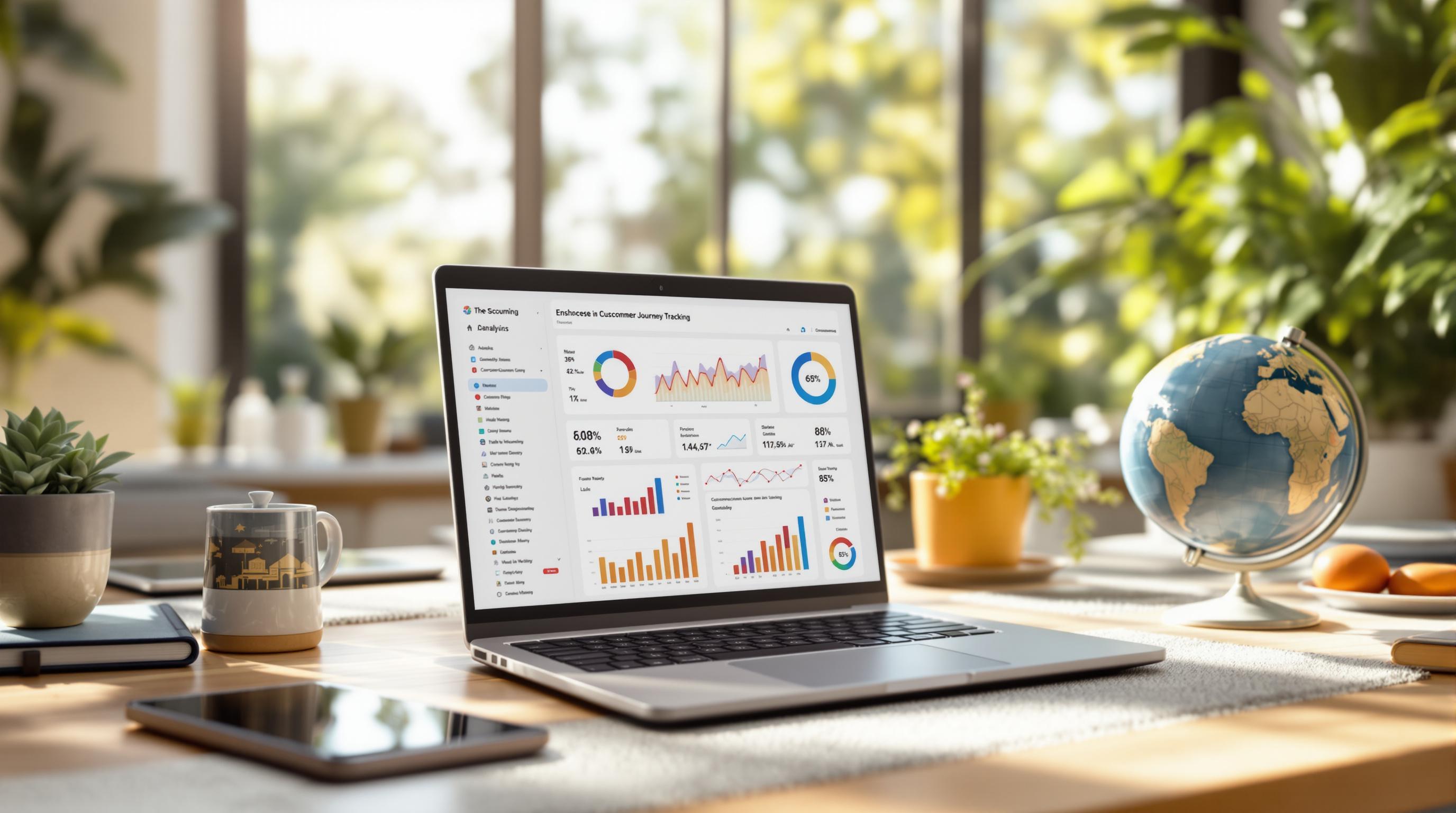RESTful APIs and GraphQL are two popular API approaches for marketing analytics. Which one should you choose? Here's a quick breakdown:
- RESTful APIs: Simple and widely used. Great for straightforward tasks like retrieving campaign metrics. However, they often over-fetch data, require multiple requests for complex queries, and can face challenges with versioning and scalability.
- GraphQL: Lets you request exactly the data you need, reducing unnecessary data transfer. Ideal for complex, real-time marketing dashboards. But, it requires more technical expertise to set up and can struggle with caching and heavy workloads.
Quick Comparison
| Aspect | RESTful APIs | GraphQL |
|---|---|---|
| Data Efficiency | Often over-fetches data | Fetches only requested fields |
| Endpoint Structure | Multiple endpoints | Single endpoint |
| Performance | May need multiple requests | Reduces network requests and payload size |
| Implementation | Straightforward setup | Requires schema and resolver setup |
| Caching | Easier with HTTP caching | More complex |
| Versioning | Requires versioning (e.g., v1, v2) | Schema evolves without versioning |
Bottom Line: Use RESTful APIs for simple, resource-based operations. Choose GraphQL for dynamic queries and advanced analytics. The right choice depends on your team's expertise and data needs.
GraphQL vs REST - Battle of the APIs
1. RESTful APIs
RESTful APIs provide a simple and widely-used method for exchanging data in marketing analytics. They are commonly employed for tasks like retrieving campaign performance metrics or integrating customer feedback systems. However, their performance characteristics can present both opportunities and hurdles.
Data Fetching
Handling large datasets is a notable challenge for REST APIs in marketing analytics. Each API call can only fetch up to 2,000 records, which means gathering extensive campaign data or detailed customer insights often requires multiple requests. According to a Stack Overflow survey, 64% of developers encounter difficulties when working with large datasets.
Pagination, which allows fetching up to 4,000 records, is often more suitable for user interfaces rather than bulk data processing. For larger datasets, alternative methods like streaming or batch processing are often necessary .
Error Handling
Effective error handling is critical for reliable marketing analytics. A reported 41% of developers frequently deal with "Incorrect API responses", and 28% of API downtime stems from poor exception handling or server misconfigurations. REST APIs commonly experience client-side errors (4xx status codes), with 401 Unauthorized and 400 Bad Request being among the most frequent. To address this, many teams implement centralized middleware to catch, log, and standardize error responses.
"Poor error handling will directly contribute to 35% of all digital transformation initiative failures." - Gartner
One real-world example highlights the risks of inadequate error handling. A London-based FX trading platform experienced latency spikes exceeding 300ms during NYSE/LSE overlap windows. This caused 19% of algorithmic trades to fail, resulting in $2.1 million in settlement penalties over six months.
Versioning
Versioning is another challenge for marketing analytics platforms that rely on multiple data sources. In fact, 68% of enterprises identify versioning as a major hurdle in API lifecycle management. Proper API versioning ensures backward compatibility, allowing existing integrations to function even when APIs are updated. Without a clear versioning strategy, updates can disrupt integrations, complicate data transformation efforts, and increase technical debt.
Performance in Complex Data Scenarios
High-traffic platforms require optimized response times, especially for real-time insights. For example, when marketing teams analyze data from multiple sources - such as social media engagement, email campaigns, and website analytics - REST APIs often need to handle numerous sequential requests. The 2,000-record limit per call becomes a bottleneck in scenarios like customer journey analysis or campaign attribution, leading to increased latency.
To mitigate these performance issues, advanced caching strategies can be employed. Layered TTL caching, where near-real-time data has shorter time-to-live (TTL) durations and historical metrics have longer TTLs, can ensure performance dashboards load quickly while maintaining up-to-date information. Additionally, rate limiting and throttling are crucial for API stability during high-traffic events, such as major campaign launches or viral social media moments.
Next, we’ll explore how GraphQL addresses some of these challenges.
2. GraphQL
GraphQL offers a modern API design that tackles many of the performance issues associated with REST, particularly in marketing analytics. Today, more than 61% of organizations use GraphQL, with some transitioning entirely away from REST. Its single endpoint architecture transforms how marketing teams access and manage data.
Data Fetching
One of GraphQL's standout features is its ability to let clients request only the data they need. Unlike REST APIs, which often return bulky datasets, GraphQL queries are tailored to include just the relevant fields. For example, instead of retrieving unnecessary data from an endpoint, GraphQL allows marketing teams to pinpoint and fetch only the metrics they require, significantly cutting down on redundant data transfer.
This level of control is especially valuable for marketing dashboards that aggregate data from multiple sources. A single GraphQL query can pull campaign performance metrics, customer demographics, and conversion stats all at once, eliminating the need for multiple API calls. This approach not only simplifies the process but also reduces resource usage - GraphQL can lower resource consumption by around 30% compared to REST for complex queries.
Error Handling
GraphQL takes a different approach to error handling compared to REST. While REST relies on HTTP status codes to signal issues, GraphQL always returns a 200 OK response, embedding error details within the response payload. This means a single response can include both the requested data and any errors.
"Unlike in REST/HTTP APIs, where error handling is based on status codes returned by the API, GraphQL request are always made using the same
/graphqlurl and always return a 200 OK response."
To manage errors effectively, teams often develop middleware to classify issues by severity, source, and type. In production settings, it’s crucial to disable debug mode to avoid exposing sensitive information and to set up alerts for critical errors that could disrupt campaigns. For federated GraphQL systems - where different data sources may return varying error formats - centralized logging tools can simplify troubleshooting across platforms.
With these error management strategies in place, GraphQL becomes even more effective in handling complex data environments.
Performance in Complex Data Scenarios
GraphQL shines when it comes to managing complex data and improving response times. Performance tests reveal that GraphQL achieves a latency of just 15 ms for 100 parallel users, compared to 1,564 ms for SQL queries. It also supports 500 requests per second, far surpassing SQL’s 28 requests per second.
"GraphQL is reshaping how applications interact with data, offering a flexible and efficient way to query and manipulate it."
- Tal Doron, AVP, Head of Presales, GigaSpaces Technologies
Efficient query design is another key strength. Tests have shown that optimized GraphQL queries can deliver a 48.18% performance improvement over more extensive queries. For marketing teams, this translates to faster dashboard load times and smoother real-time reporting.
GraphQL’s strong typing system adds another layer of reliability by ensuring data consistency across intricate marketing datasets. Its schema provides instant access to data structure details, making it easier to develop error-free analytics dashboards. This is particularly useful when combining data from multiple marketing channels, customer interactions, and conversion pathways.
Thanks to its flexible querying capabilities, GraphQL integrates seamlessly with front-end applications and microservices. This fits perfectly with the API-first strategies that many marketing technology stacks rely on, allowing teams to quickly update their analytics interfaces without requiring backend modifications.
sbb-itb-5174ba0
Advantages and Disadvantages
When deciding between RESTful APIs and GraphQL for marketing analytics, understanding their strengths and limitations is key. Each approach offers distinct benefits and challenges that can shape how effectively data is retrieved and managed - both critical factors for making timely marketing decisions.
RESTful APIs are known for their simplicity and reliability. Their lightweight, scalable design separates client and server operations clearly, supports multiple data formats, and benefits from extensive industry adoption and tooling. Bruce Rowe, President of Sebo Marketing, shared that his team "gets things done about 20% faster" when working with well-established REST implementations.
However, in complex marketing analytics scenarios, RESTful APIs can become cumbersome. Managing multiple endpoints often becomes challenging as marketing technology stacks grow more sophisticated.
GraphQL, on the other hand, addresses some of REST's shortcomings. Its flexible querying capabilities allow teams to fetch only the data they need, reducing data transfer and improving efficiency. Additionally, its schema flexibility enables seamless updates without disrupting analytics workflows. With its single-endpoint architecture, GraphQL simplifies communication between microservices and is especially useful for teams handling data from various marketing channels. Frontend developers also appreciate the ability to craft custom queries, which can speed up the creation of dashboards and reports.
That said, GraphQL comes with its own set of challenges. Caching and security implementations can be more complex. For instance, its single endpoint may become a bottleneck under heavy workloads - testing showed GraphQL underperformed compared to REST when handling over 3,000 requests. Moreover, setting up GraphQL requires more upfront effort and technical expertise due to its schema-based approach.
Here’s a quick comparison of the two approaches:
| Aspect | RESTful APIs | GraphQL |
|---|---|---|
| Data Efficiency | Often over-fetches, returning entire resources | Fetches only requested fields, avoiding unnecessary data |
| Endpoint Structure | Multiple endpoints for different resources | Single endpoint for all data requests |
| Performance | May require multiple requests for related data | Reduces network requests and payload size |
| Implementation | Straightforward setup based on REST principles | More complex due to schema and resolver requirements |
| Caching | Easier with built-in HTTP caching methods | More challenging without native HTTP caching support |
| Versioning | Requires API versioning (e.g., v1, v2) | Schema evolves without needing versioning |
| Flexibility | Server defines response format | Clients define response structure |
For marketing analytics, the choice between RESTful APIs and GraphQL often hinges on your team’s technical expertise and the complexity of your data needs. RESTful APIs are ideal for straightforward, resource-based operations where simplicity is crucial. GraphQL, however, shines in scenarios requiring dynamic queries and real-time updates.
Ultimately, the decision comes down to weighing the complexity of implementation against the potential performance improvements and scalability for your marketing analytics infrastructure.
Conclusion
Deciding between RESTful APIs and GraphQL for marketing analytics boils down to your technical resources and the complexity of your data. Each option brings distinct benefits that can shape how effectively your analytics perform.
GraphQL shines when dealing with complex marketing data. Its ability to fetch exactly what you need in a single request avoids the common issues of over-fetching or under-fetching seen with RESTful APIs. This precision often leads to faster dashboard load times and more efficient real-time reporting - key advantages when quick decisions are needed to adjust campaigns.
RESTful APIs are ideal for simpler needs. If your analytics focus on basic metrics or straightforward customer data management, REST’s simplicity and broad tooling support make it a practical and cost-effective choice. These strengths make REST a reliable option for less demanding use cases.
GraphQL reduces data transfer and minimizes request overhead, making it a great fit for handling intricate queries. On the other hand, REST’s stateless design and straightforward caching excel under high-traffic conditions. The best choice depends on balancing your team’s technical expertise, the complexity of your data, and scalability requirements. GraphQL is better suited for advanced queries, while REST remains a dependable solution for simpler tasks.
To help businesses navigate these options, the Marketing Analytics Tools Directory provides a detailed comparison of platforms supporting both RESTful and GraphQL implementations. It’s a valuable resource for finding tools that align with your API strategy and analytics goals.
FAQs
What are the key differences between RESTful APIs and GraphQL when managing large datasets in marketing analytics?
RESTful APIs often involve making several requests to gather large or interconnected datasets. This can lead to increased network traffic and slower performance, which isn't ideal in marketing analytics where speed and efficiency are crucial. Handling intricate data structures with this approach can sometimes feel cumbersome.
GraphQL offers a different approach. It lets clients request precisely the data they need in a single query, which can streamline the process when working with large, complex datasets. That said, it does come with its own set of challenges. For instance, its complexity and issues with caching can strain server performance, especially when managing massive amounts of data.
Each technology has its advantages, and the best choice depends on your marketing analytics goals and the infrastructure you have in place.
What challenges might arise when using GraphQL for marketing analytics, and how can they be resolved?
Using GraphQL for marketing analytics comes with its own set of hurdles. These include added complexity, a steep learning curve for teams, and challenges in caching and securing data. Its flexibility, while powerful, can also expose systems to risks like overly complex queries or even potential DoS attacks.
To tackle these challenges, you can adopt strategies like analyzing query complexity, setting limits on query depth, and enforcing strong security measures. Staying on top of updates within the GraphQL ecosystem and providing continuous training for your team can further help you adapt to this evolving technology while ensuring it integrates smoothly into your marketing analytics processes.
When should marketing teams switch from RESTful APIs to GraphQL for analytics?
Marketing teams might want to look into GraphQL when they’re aiming for greater flexibility and efficiency in how they retrieve data. This is especially true for teams juggling multiple data sources or dealing with constantly changing data needs. With GraphQL, you can request only the data you need through a single endpoint, cutting down on unnecessary data transfer.
This approach shines in marketing analytics, where pulling real-time insights from various data sources is often essential. If reducing the number of requests and boosting performance is a key focus - like when fetching related or nested data in one go - GraphQL can simplify workflows and make data retrieval much more efficient.


